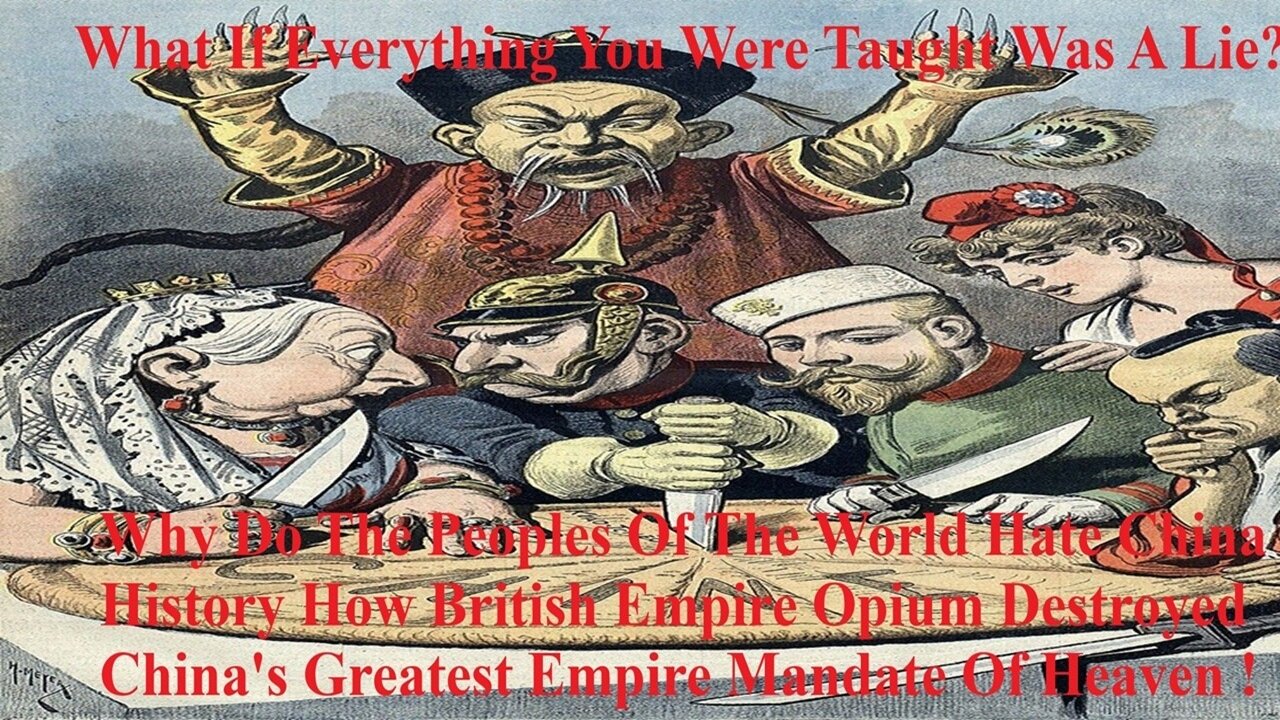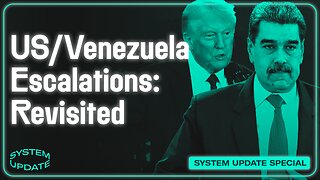Premium Only Content

A True History Of How British Empire Opium Destroyed China's Greatest Empire Mandate Of Heaven
Why Do The Peoples Of The World Hate China ? Fentanyl ? California Black Reparations ? Really ? A True History How British Opium Destroyed China's Greatest Empire Of The World For 2000 Years And Our True Mandate Of Heaven. The Opium Wars Under the East India Company, Our ancestors were pushed to grow opium instead of food. I carry the memory of a time when our fields were taken from us not by force, but by control. Hunger grew at home while profits sailed away. The wealth it brought built empires, not our villages. “It’s haunting to realize an empire that survived wars and rebellions was ultimately undone by something as small as a puff of smoke. History whispers louder than cannons sometimes.”
It's wild how empires don’t always collapse with gunfire sometimes, they dissolve in silence, puff by puff. So opium went there to China, and now fentanyl comes here to American.
This story isn't just about the Qing Dynasty. It's about how human weakness, greed, and misplaced pride can unravel even the most powerful systems.
The fact that a foreign substance could unravel centuries of culture and power is chilling. Was it weakness or calculated sabotage? This reminds me how economic control often starts with dependency. How many modern empires are built on something just as fragile?
It wasn’t an army that brought the empire to its knees it was a flower turned weapon. How do you fight a war… when the battlefield is inside your mind?
Could you have seen it coming? British literally turned 'Plant Trafficking' into an empire-ending superweapon. That’s not history, that’s a villain origin story!”
Thank you for this video, it was really fascinating. It’s discussing that Britain led the world in this trade, and went to war to make sure it was continued. I'm English but if I was Chinese I don’t think I would forgive or forget what was done to my country and its people, all in the pursuit of money. I hope my government has apologized at some point.
I’m still stunned by the description of foreign merchants making a fortune while entire villages collapsed into drug addiction. And how some of that wealth funded universities and public works in the West? It’s so morally complex that it’s painful to think about. Should we view historical prosperity differently when it comes with such a huge hidden cost?
Now i understand the Chinese attitude towards the west and generally why they are so strict on narcotics. I can’t stop thinking, did the people at the time realize it was the beginning of the end, or did it just feel like another bad year? Imagine losing control of one‑third of the world’s wealth… not because of a warship, but because of a pipe. This story feels like a warning for our own time.
Mandate of Heaven
The Mandate of Heaven (Tianming) is an ancient Chinese political and philosophical concept that served as the foundation for the legitimacy of rulers, particularly emperors, throughout much of Chinese history.
It originated with the Zhou dynasty around 1046 BCE, following their overthrow of the Shang dynasty at the Battle of Muye, and was used to justify their rule by claiming they had received divine approval from Heaven (Tian).
According to this doctrine, Heaven bestowed the mandate on a virtuous ruler, who was known as the "Son of Heaven," granting them the right to rule over Tianxia, meaning "all under heaven".
The mandate was not hereditary or permanent; it could be lost if the ruler became unjust, corrupt, or failed to govern wisely.
Signs of losing the mandate included natural disasters like droughts, famines, floods, and earthquakes, as well as social unrest, peasant uprisings, and foreign invasions, all interpreted as Heaven's displeasure.
This concept also provided a theoretical justification for rebellion against an unjust ruler, allowing for dynastic change.
The idea persisted through imperial China, influencing political thought until the end of imperial rule in 1911, and continues to be referenced in modern discussions about political legitimacy in China.
Opium's Impact on China
The Opium Wars, fought between the Qing Dynasty and Western powers in the mid-19th century, were pivotal events that severely weakened China's imperial system and are often seen as the beginning of the end for the Qing Dynasty.
The conflict stemmed from a trade imbalance where China exported valuable goods like tea, silk, and porcelain, but Britain had few goods China desired, leading to a massive outflow of silver.
To counter this, the British East India Company began smuggling Indian opium into China, which became a highly profitable enterprise.
Despite Qing prohibitions on opium dating back to 1729, the addictive nature of the drug led to a massive increase in consumption; by the 1830s, an estimated 10–12 million Chinese were addicted.
This addiction drained the empire's silver reserves and caused widespread social and economic disruption.
In response, the Daoguang Emperor appointed the hardline official Lin Zexu to suppress the opium trade in 1839. Lin confiscated and destroyed over 20,000 chests of opium (approximately 1,300 tonnes or 2.9 million pounds) in a public ceremony at Humen.
This action, while a powerful symbol of resistance, provoked the British government, which saw the destruction of private property as an affront to free trade and demanded compensation.
The British government responded by sending a naval expedition, marking the start of the First Opium War.
The superior military technology of the British Royal Navy led to decisive victories, culminating in the Treaty of Nanking in 1842. This "Unequal Treaty" forced China to cede Hong Kong Island to Britain, open five treaty ports to foreign trade, pay substantial reparations, and grant extraterritorial rights to British citizens.
The Second Opium War (1856–1860) further devastated the Qing Dynasty. It was triggered by the seizure of the British-registered ship Arrow and the execution of a French missionary, leading to a coalition of British and French forces.
The war resulted in the Treaty of Tientsin (Tianjin), which legalized the opium trade, opened more ports, allowed foreign diplomats to reside in Beijing, and granted missionaries the right to travel and operate freely within China.
The war's climax was the burning of the Summer Palace by Anglo-French forces in 1860, a symbolic act of imperial humiliation.
These conflicts, along with the massive indemnities and the loss of sovereignty, severely weakened the Qing government's authority and legitimacy.
The wars also coincided with internal rebellions, most notably the Taiping Rebellion (1850–1864), which killed an estimated 20 million people and further strained the state's resources.
The cumulative effect of the Opium Wars, the resulting "Century of Humiliation," and internal strife ultimately contributed to the fall of the Qing Dynasty in 1911.
Britain Empire
The British Empire was a worldwide system of dependencies, including colonies, protectorates, and other territories, brought under the sovereignty of the crown of Great Britain and the administration of the British government over a span of some three centuries, beginning in the 16th century and lasting until the end of the 20th century.
Its foundations were laid with the establishment of overseas settlements in the late 16th and early 17th centuries, such as the failed Roanoke Colony in 1585 and the successful Jamestown settlement in 1607.
The empire's growth was driven by maritime expansion, commercial ambitions, and competition with other European powers like France and the Netherlands.
Key events included the conquest of Mughal Bengal at the Battle of Plassey in 1757, which secured British dominance in India, and the Treaty of Paris in 1763, which made Britain dominant in Canada after the Seven Years' War.
At its height in the 19th and early 20th centuries, the British Empire became the largest empire in history and the foremost global power for over a century.
By 1920, it covered 35.5 million km² (13.7 million sq mi), approximately 24% of the Earth's total land area, and held sway over 412 million people, representing 23% of the world's population at the time.
This vast reach led to the description of the empire as "the empire on which the sun never sets," as the sun was always shining on at least one of its territories.
The period of relative peace and dominance from 1815 to 1914 was later termed Pax Britannica.
The empire's decline began after the First World War, accelerated by the Second World War, and was marked by the independence of India in 1947 and the Suez Crisis of 1956.
The last significant colony, Hong Kong, was returned to Chinese sovereignty in 1997, symbolizing the end of the empire for many.
The British Empire no longer exists, but its legacy persists through the Commonwealth of Nations, a free association of sovereign states comprising the United Kingdom and many of its former dependencies, which acknowledge the British monarch as a symbolic head.
British Opium War China
The narrative of the British Empire's opium trade leading to the decline of China's Qing dynasty and the erosion of its Mandate of Heaven is a complex historical interpretation, often framed by the events of the Opium Wars. The First Opium War (1839–1842) was triggered when the Qing government, under Emperor Daoguang, tasked Commissioner Lin Zexu with enforcing a ban on opium, which had become rampant due to British and American smuggling.
Lin confiscated and publicly destroyed over 1,420 tonnes of opium in 1839, a decisive act that provoked the British government.
The British, motivated by the immense profits from the opium trade Britain's single most profitable commodity of the 19th century and the need to protect their merchants' interests, responded by sending a naval expedition.
The conflict was not solely about opium; it also involved disputes over trade rights, diplomatic equality, and the principle of free trade.
The war highlighted the technological and military superiority of the British Royal Navy, which used steam-powered ships and advanced weaponry to inflict a series of decisive defeats on the Qing forces, who relied on antiquated weapons and ships.
The war concluded with the Treaty of Nanking in 1842, the first of the "Unequal Treaties," which forced China to cede Hong Kong Island to Britain, open five treaty ports to foreign trade, pay a large indemnity, and grant extraterritorial rights to British citizens.
This treaty, and the subsequent Second Opium War (1856–1860), which resulted in the legalization of the opium trade and further concessions, are seen by many Chinese historians as the beginning of a "Century of Humiliation," a period during which foreign powers undermined Chinese sovereignty and authority.
While the opium trade was a central catalyst, the decline of the Qing dynasty was influenced by a confluence of factors, including internal corruption, population pressures, and the devastating Taiping Rebellion (1850–1864), which claimed an estimated 20 million lives.
The term "Mandate of Heaven," a traditional Chinese philosophical concept justifying the emperor's rule, was increasingly questioned as the Qing government failed to protect the nation from foreign aggression and internal collapse.
The Opium Wars are thus often viewed as a pivotal moment that shattered the Qing's legitimacy in the eyes of its people and marked the beginning of the end for imperial China, paving the way for the eventual fall of the dynasty in 1912.
The legacy of these conflicts continues to influence modern Chinese nationalism and foreign policy, with leaders like Xi Jinping invoking the "Century of Humiliation" to promote a vision of national rejuvenation.
The Opium Wars in the mid-19th century were a critical juncture in modern Chinese history. The first Opium War was fought between China and Great Britain from 1839 to 1842. In the second Opium War, from 1856 to 1860, a weakened China fought both Great Britain and France. China lost both wars. The terms of its defeat were a bitter pill to swallow: China had to cede the territory of Hong Kong to British control, open treaty ports to trade with foreigners, and grant special rights to foreigners operating within the treaty ports. In addition, the Chinese government had to stand by as the British increased their opium sales to people in China. The British did this in the name of free trade and without regard to the consequences for the Chinese government and Chinese people.
The lesson that Chinese students learn today about the Opium Wars is that China should never again let itself become weak, ‘backward,’ and vulnerable to other countries. As one British historian says, “If you talk to many Chinese about the Opium War, a phrase you will quickly hear is ‘luo hou jiu yao ai da,’ which literally means that if you are backward, you will take a beating.”1
Two Worlds Collide: The First Opium War
In the mid-19th century, western imperial powers such as Great Britain, France, and the United States were aggressively expanding their influence around the world through their economic and military strength and by spreading religion, mostly through the activities of Christian missionaries. These countries embraced the idea of free trade, and their militaries had become so powerful that they could impose such ideas on others. In one sense, China was relatively effective in responding to this foreign encroachment; unlike its neighbours, including present-day India, Burma (now Myanmar), Malaya (now Malaysia), Indonesia, and Vietnam, China did not become a full-fledged, formal colony of the West. In addition, Confucianism, the system of beliefs that shaped and organized China’s culture, politics, and society for centuries, was secular (that is, not based on a religion or belief in a god) and therefore was not necessarily an obstacle to science and modernity in the ways that Christianity, Islam, and Hinduism sometimes were in other parts of the world.
But in another sense, China was not effective in responding to the “modern” West with its growing industrialism, mercantilism, and military strength. Nineteenth-century China was a large, mostly land-based empire (see Map 1), administered by a c. 2,000-year-old bureaucracy and dominated by centuries old and conservative Confucian ideas of political, social, and economic management. All of these things made China, in some ways, dramatically different from the European powers of the day, and it struggled to deal effectively with their encroachment. This ineffectiveness resulted in, or at least added to, longer-term problems for China, such as unequal treaties (which will be described later), repeated foreign military invasions, massive internal rebellions, internal political fights, and social upheaval. While the first Opium War of 1839–42 did not cause the eventual collapse of China’s 5,000-year imperial dynastic system seven decades later, it did help shift the balance of power in Asia in favour of the West.
Opium and the West’s Embrace of Free Trade
In the decades leading up to the first Opium War, trade between China and the West took place within the confines of the Canton System, based in the southern Chinese city of Guangzhou (also referred to as Canton). An earlier version of this system had been put in place by China under the Ming Dynasty (1368–1644), and further developed by its replacement, the Qing Dynasty, also known as the Manchu Dynasty. (The Manchus were the ethnic group that ruled China during the Qing period.) In the year 1757, the Qing emperor ordered that Guangzhou/Canton would be the only Chinese port that would be opened to trade with foreigners, and that trade could take place only through licensed Chinese merchants. This effectively restricted foreign trade and subjected it to regulations imposed by the Chinese government.
For many years, Great Britain worked within this system to run a three country trade operation: It shipped Indian cotton and British silver to China, and Chinese tea and other Chinese goods to Britain. In the 18th and early 19th centuries, the balance of trade was heavily in China’s favour. One major reason was that British consumers had developed a strong liking for Chinese tea, as well as other goods like porcelain and silk. But Chinese consumers had no similar preference for any goods produced in Britain. Because of this trade imbalance, Britain increasingly had to use silver to pay for its expanding purchases of Chinese goods. In the late 1700s, Britain tried to alter this balance by replacing cotton with opium, also grown in India. In economic terms, this was a success for Britain; by the 1820s, the balance of trade was reversed in Britain’s favour, and it was the Chinese who now had to pay with silver.
The Scourge and Profit of Opium
The opium that the British sold in China was made from the sap of poppy plants, and had been used for medicinal and sometimes recreational purposes in China and other parts of Eurasia for centuries. After the British colonized large parts of India in the 17th century, the British East India Company, which was created to take advantage of trade with East Asia and India, invested heavily in growing and processing opium, especially in the eastern Indian province of Bengal. In fact, the British developed a profitable monopoly over the cultivation of opium that would be shipped to and sold in China.
By the early 19th century, more and more Chinese were smoking British opium as a recreational drug. But for many, what started as recreation soon became a punishing addiction: many people who stopped ingesting opium suffered chills, nausea, and cramps, and sometimes died from withdrawal. Once addicted, people would often do almost anything to continue to get access to the drug. The Chinese government recognized that opium was becoming a serious social problem and, in the year 1800, it banned both the production and the importation of opium. In 1813, it went a step further by outlawing the smoking of opium and imposing a punishment of beating offenders 100 times.
In response, the British East India Company hired private British and American traders to transport the drug to China. Chinese smugglers bought the opium from British and American ships anchored off the Guangzhou coast and distributed it within China through a network of Chinese middlemen. By 1830, there were more than 100 Chinese smugglers’ boats working the opium trade.
This reached a crisis point when, in 1834, the British East India Company lost its monopoly over British opium. To compete for customers, dealers lowered their selling price, which made it easier for more people in China to buy opium, thus spreading further use and addition.
In less than 30 years from 1810 to 1838 opium imports to China increased from 4,500 chests (the large containers used to ship the drug) to 40,000. As Chinese consumed more and more imported opium, the outflow of silver to pay for it increased, from about two million ounces in the early 1820s to over nine million ounces a decade later. In 1831, the Chinese emperor, already angry that opium traders were breaking local laws and increasing addiction and smuggling, discovered that members of his army and government (and even students) were engaged in smoking opium.
The Users Versus Pushers Debate
By 1836, the Chinese government began to get more serious about enforcing the 1813 ban. It closed opium dens and executed Chinese dealers. But the problem only grew worse. The emperor called for a debate among Chinese officials on how best to deal with the crisis. Opinion were polarized into two sides.
One side took a pragmatic approach (that is, an approach not focused on the morality of the issue). It focused on targeting opium users rather than opium producers. They argued that the production and sale of opium should be legalized and then taxed by the government. Their belief was that taxing the drug would make it so expensive that people would have to smoke less of it or not smoke it at all. They also argued that the money collected from taxing the opium trade could help the Chinese government reduce revenue shortfalls and the outflow of silver.
Another side vehemently disagreed with this ‘pragmatic’ approach. Led by Lin Zexu, a very capable and ambitious Chinese government official, they argued that the opium trade was a moral issue, and an “evil” that had to be eliminated by any means possible. If they could not suppress the trade of opium and addiction to it, the Chinese empire would have no peasants to work the land, no townsfolk to pay taxes, no students to study, and no soldiers to fight. They argued that instead of targeting opium users, they should stop and punish the “pushers” who imported and sold the drug in China.
In the end, Lin Zexu’s side won the argument. In 1839, he arrived in Guangzhou (Canton) to supervise the ban on the opium trade and to crack down on its use. He attacked the opium trade on several levels. For example, he wrote an open letter to Queen Victoria questioning Britain’s political support for the trade and the morality of pushing drugs. More importantly, he made rapid progress in enforcing the 1813 ban by arresting over 1,600 Chinese dealers and seizing and destroying tens of thousands of opium pipes. He also demanded that foreign companies (British companies, in particular) turn over their supplies of opium in exchange for tea. When the British refused to do so, Lin stopped all foreign trade and quarantined the area to which these foreign merchants were confined.
After six weeks, the foreign merchants gave in to Lin’s demands and turned over 2.6 million pounds of opium (over 20,000 chests). Lin’s troops also seized and destroyed the opium that was being held on British ships the British superintendent claimed these ships were in international waters, but Lin claimed they were anchored in and around Chinese islands. Lin then hired 500 Chinese men to destroy the opium by mixing it with lime and salt and dumping it into the bay. Finally, he pressured the Portuguese, who had a colony in nearby Macao, to expel the uncooperative British, forcing them to move to the island of Hong Kong.
Taken together, these actions raised the tensions that led to the outbreak of the first Opium War. For the British, Lin’s destruction of the opium was an affront to British dignity and their concepts of trade. Many British merchants, smugglers, and the British East India Company had argued for years that China was out of touch with “civilized” nations, which practised free trade and maintained “normal” international relations through consular officials and treaties. More to the point, British representatives in Guangzhou requested that merchants turn over their opium to Lin, guaranteeing that the British government would compensate them for their losses. The idea was that in the short term, this would prevent a major conflict, and that it would keep the merchants and ship captains safe while reopening the extremely profitable China trade in other goods.
The huge opium liability (the opium was worth millions of pounds sterling), and increasingly shrill demands from merchants in China, India, and London when they discovered their profits were destroyed, gave politicians in Great Britain the excuse they were looking for to act more forcefully to expand British imperial interests in China. War broke out in November 1839 when Chinese warships clashed with British merchantmen.
In June 1840, 16 British warships and merchantmen many leased from the primary British opium producer, Jardine Matheson & Co. arrived at Guangzhou. Over the next two years, the British forces bombarded forts, fought battles, seized cities, and attempted negotiations. A preliminary settlement called for China to cede Hong Kong to the British Empire, pay an indemnity, and grant Britain full diplomatic relations. It also led to the Qing government sending Lin Zexu into exile. Chinese troops, using antiquated guns and cannons, and with limited naval ships, were largely ineffective against the British. Dozens of Chinese officers committed suicide when they could not repel the British marines, steamships, and merchantmen.
The War’s Aftermath
The first Opium War ended in 1842, when Chinese officials signed, at gunpoint, the Treaty of Nanjing. The treaty provided extraordinary benefits to the British, including:
an excellent deep-water port at Hong Kong; a huge indemnity (compensation) to be paid to the British government and merchants; five new Chinese treaty ports at Guangzhou (Canton), Shanghai, Xiamen (Amoy), Ningbo, and Fuzhou, where British merchants and their families could reside; extraterritoriality for British citizens residing in these treaty ports, meaning that they were subject to British, not Chinese, laws; and a “most favoured nation” clause that any rights gained by other foreign countries would automatically apply to Great Britain as well.
For China, the Treaty of Nanjing provided no benefits. In fact, Chinese imports of opium rose to a peak of 87,000 chests in 1879. After that, imports of opium declined, and then ended during the First World War, as opium production within China outgrew foreign production. However, other trade did not expand as much as foreign merchants had hoped, and they continued to blame the Chinese government for this. Among Chinese officials, the aftermath of the war led to a bitter political struggle between two factions: a peace faction, which was roughly aligned with the ‘users’ faction in the opium trade debate; and a ‘war’ faction, which was roughly aligned with the ‘pushers’ faction in that debate. The peace faction was in nominal control.
In addition, the Treaty of Nanjing ended the Canton System that had been in place since the 17th century. This was followed in 1844 by a system of unequal treaties between China and western powers. Through the most favoured nation clauses, these treaties allowed westerners to build churches and spread Christianity in the treaty ports. Western imperialism and free trade had its first great victory in China with this war and its resulting treaties.
When the Chinese emperor died in 1850, his successor dismissed the peace faction in favour of those who had supported Lin Zexu. The new emperor tried to bring Lin back from exile, but Lin died along the way. The Chinese court kept finding excuses not to accept foreign diplomats at the capital city of Beijing, and its compliance with the treaties fell far short of western countries’ expectations.
Second Opium War (1856–1860)
In 1856, a second Opium War broke out and continued until 1860, when the British and French captured Beijing and forced on China a new round of unequal treaties, indemnities, and the opening of 11 more treaty ports. This also led to increased Christian missionary work and legalization of the opium trade.
Even though new ports were opened to British merchants after the first Opium War, the Chinese dragged their feet on implementing the agreements, and legal trade with China remained limited. British merchants pressed their government to do more, but the government’s hands were tied because the Chinese government in the capital city of Beijing restricted who it met with.
In October 1856, Chinese authorities arrested the Chinese crew of a ship operated by the British. The British used this as an opportunity to pressure China militarily to open itself up even further to British merchants and trade. France, using the execution in China of a French Christian missionary as an excuse, joined the British in the fight. Joint French-British forces captured Guangzhou before moving north to the city of Tianjin (also referred to as Tientsin). In 1858, the Chinese agreed—on paper—to a series of western demands contained in documents like the Treaty of Tientsin. But then they refused to ratify the treaties, which led to further hostilities.
In 1860, British and French troops landed near Beijing and fought their way into the city. Negotiations quickly broke down and the British High Commissioner to China ordered the troops to loot and destroy the Imperial Summer Palace, a complex and garden where Qing Dynasty emperors had traditionally handled the country’s official matters.
Shortly after that, the Chinese emperor fled to Manchuria in northeast China. His brother negotiated the Convention of Beijing, which, in addition to ratifying the Treaty of Tientsin, added indemnities and ceded to Britain the Kowloon Peninsula across the strait from Hong Kong. The war ended with a greatly weakened Qing Dynasty that was now confronted with the need to rethink its relations with the outside world and to modernize its military, political, and economic structures.
Thinking About the Opium War
In 1839, the British imposed on China their version of free trade and insisted on the legal right of their citizens (that is, British citizens) to do what they wanted, wherever they wanted. Chinese critics point out that while the British made lofty arguments about the ‘principle’ of free trade and individual rights, they were in fact pushing a product (opium) that was illegal in their own country.
There are different viewpoints on what was the main underlying factor in Britain’s involvement in the Opium Wars. Some in the west claim that the Opium Wars were about upholding the principle of free trade. Others, however, say that Great Britain was acting more in the interest of protecting its international reputation while it was facing challenges in other parts of the world, such as the Near East, India, and Latin America. Some American historians have argued that these conflicts were not so much about opium as they were about western powers’ desire to expand commercial relations more broadly and to do away with the Canton trading system. Finally, some western historians say the war was fought at least partly to keep China’s balance of trade in a deficit, and that opium was an effective way to do that, even though it had very negative impacts on Chinese society.
It is important to point out that not everyone in Britain supported the opium trade in China. In fact, members of the British public and media, as well as the American public and media, expressed outrage over their countries’ support for the opium trade.
From China’s historical perspective, the first Opium War was the beginning of the end of late Imperial China, a powerful dynastic system and advanced civilization that had lasted thousands of years. The war was also the first salvo in what is now referred to in China as the “century of humiliation.” This humiliation took many forms. China’s defeat in both wars was a sign that the Chinese state’s legitimacy and ability to project power were weakening.
The Opium Wars further contributed to this weakening. The unequal treaties that western powers imposed on China undermined the ways China had conducted relations with other countries and its trade in tea. The continuation of the opium trade, moreover, added to the cost to China in both silver and in the serious social consequences of opium addiction. Furthermore, the many rebellions that broke out within China after the first Opium War made it increasingly difficult for the Chinese government to pay its tax and huge indemnity obligations.
Present-day Chinese historians see the Opium Wars as a wars of aggression that led to the hard lesson that “if you are ‘backward,’ you will take a beating.” These lessons shaped the rationale for the Chinese Revolution against imperialism and feudalism that emerged, and then succeeded, decades later.
1839-1842: First Opium (First Anglo-Chinese) War. Treaty of Nanking signed (1842) ending the First Opium War. China to pay large indemnity and extraterritoriality and most favored nation principle established in China
1856-1860: The Second Opium (Anglo-Chinese)War. Convention of Peking signed ending the war, opening eleven more Chinese cities to foreign trade, freedom of religion now allowed in China, legalized opium, Britain, France, Russia and U.S. est. diplomatic legations in Peking, foreign commercial vessels allowed on Yangtze and the right of foreigners to travel throughout China.
1850-1864: Taiping Rebellion-most deadliest civil rebellion to date. Approximately 20 million killed.
1861: Tongzhi reign. Rise of power of Empress Dowager Cixi.
1882: Chinese Exclusion Act passed in the United States severely limiting immigration.
1884-1885: China defeated in war with France. Establishment of French Indo-China.
1894-1895: Sino-Japanese War. China defeated. Treaty of Shimonoseki signed.
1895-1900: Establishment of concessions in Shanghai and other coastal cities.
1900: Boxer Siege (Boxer Rebellion) of Beijing; lifted by eight allied armies. A year later Boxer Protocol signed.
1905: Sun Yat-sen establishes the Revolutionary Alliance, precursor to GMD (Guómindӑng-Nationalist Party). Abolition of the civil service examination.
1911: The First People’s Republic of China Proclaimed, fall of the Manchu Qing Dynasty (founded in 1644.)
1912: Sun inaugurated as first president of Republic of China (ROC). He abdicates.
1914: World War I begins. China is allied with United States and Great Britain.
1915: Yuan Shikai (Sun’s successor as President) negotiates Japan’s Twenty-one Demands.
1915: New Youth magazine launched, New Culture movement begins .
1916-1926: Warlord period.
1919: Treaty of Versailles signed – Shandong in dispute.
1919: May 4th Movement (student-led anti-Japanese, anti-warlord, multi-class movement) Sparked in protest to China’s treatment at Versailles.
1921: Founding of the Chinese Communist Party (CCP) in Shanghai.
1926-1927: First United Front alliance between Nationalists and CCP.
1924: Johnson-Reed Immigration Act excluding all immigration from Asia.
1925: Sun Yat-sen dies; May 30th Movement begins (multi-class, anti-imperialist struggle.)
1926-1927: Northern Expedition (anti-warlord military campaign) begins. Led by General Chiang Kai-shek reunifies China under Nationalist government.
1927: Nationalists launch anti-communist purge. Nanjing Decade begins.
1931: Japanese expansion in Manchuria (Mukden Incident.)
1934: Chiang Kai-shek’s New Life Movement begins.
1934: Long March Communist headquarters in Yenan under leadership of Mao Zedong (1893-1976.)
1936: Xian Incident (Chiang Kai-shek kidnapped until he agrees to ally with CCP.)
July 7, 1937: Marco Polo Bridge Incident in China initiates invasion of mainland China. Battle of Shanghai follows from mid August-November followed by the occupation of Beijing and the then capital city, Nanjing.
December 13, 1937: Nanjing occupied. Height of mass violence lasts until February 1938. Nanjing remains an occupied city throughout World War II in China.
1937-1945: Span of World War II in mainland Asia.
1938: Chiang Kai-shek moves capital to Chungking in early 1938.
1939: Outbreak of World War II in Europe.
1941: U.S. enters war after Imperial Army attack on Pearl Harbor-December 7th.
1945: Soviet Union enters war against Japan (August 9th) invading Manchuria. First atomic bomb dropped on Hiroshima (August 7th) and Nagasaki (August 9th.) Japan surrenders August 15, 1945. End of World War II in Asia.
1946: International Military Tribunal for the Far East, or the Tokyo Trials begins. The United States occupies Japan under provisions of surrender. Nanjing War Crimes Tribunal also begins.
1945-1949: Civil War between Nationalists and Communists
1949: People’s Republic of China begins?
The Four Great Inventions of ancient China papermaking, the compass, gunpowder, and printing—are celebrated for their profound historical significance and global impact on civilization.
These innovations, originating in imperial China, significantly advanced science, technology, and culture, with their influence spreading worldwide centuries after their invention.
Papermaking was traditionally attributed to Cai Lun, an official of the Han dynasty, around 105 AD, who developed a method using mulberry bark, fishing nets, old rags, and hemp waste.
This invention revolutionized writing materials, replacing cumbersome bamboo strips and heavy silk, and enabled the efficient recording and dissemination of information.
While paper for wrapping existed earlier, its use as a widespread writing medium became common by the 3rd century.
The compass, initially developed during the Warring States period as a "south-governor" (sīnán) using lodestone, evolved into a navigational tool. The first documented use of a magnetic needle in a compass appeared in the 11th century, with Shen Kuo describing a suspended magnetic needle in 1088.
By the Northern Song dynasty, a spherical compass with a magnetic needle was in use, and the device was later transmitted to the Arab world and Europe.
Gunpowder was first developed by Chinese alchemists in the 9th century during their search for an elixir of immortality. Early records, such as a text from around 850 AD, describe its explosive properties when saltpetre, sulfur, and charcoal were heated together.
By the 11th century, the Wujing Zongyao treatise detailed gunpowder formulas with nitrate levels up to 50%, and by the 13th century, Chinese forces used explosive grenades and land mines.
The explosive potential was further refined by the mid-14th century in the Huolongjing, which described formulas with nitrate levels reaching 91%.
Printing was first recorded in China during the Tang dynasty (618–906 AD), with the earliest surviving examples of printed cloth patterns predating 220 AD. Woodblock printing became the dominant method for centuries, and by the 9th century, movable type printing was developed, further accelerating the spread of knowledge. The first mention of printing was an imperial decree from 593 AD mandating the printing of Buddhist scriptures.
These four inventions profoundly reshaped world history: printing transformed literature and education, gunpowder revolutionized warfare, and the compass enabled global exploration and trade.
Their introduction to Europe, largely through Arab traders during the Renaissance, played a crucial role in the development of modern Western civilization.
True Chinese Cultural Revolution Decade And Tiananmen Square Protests Massacre - https://rumble.com/v2p60ry-true-chinese-cultural-revolution-decade-and-tiananmen-square-protests-massa.html
The Chinese Revolution spanned much of the 20th century and would become a transformative event in world history. Its outcomes continue to shape China and its region and resonate through our modern world. Today, the People’s Republic of China is one of the most powerful nations on Earth. With its huge population, a diverse economy worth around $US18 trillion per annum as of 2023, and the most imposing military force in Asia, China appears destined to become the world’s preeminent superpower.
Despite this, China was a comparative latecomer to the modern world. At the turn of the 20th century, the Chinese nation was fragmented and still mired in the past. Its government was dominated by feudal monarchs who claimed to rule on behalf of heaven. Its economy was largely agricultural, carried by laboring peasants, while its social structures, practices and traditions were more medieval than modern.
Real True History China And A American Old WW-2 Friends Now Roots of Madness - https://rumble.com/v2ozxnq-real-true-history-china-and-a-american-old-ww-2-friends-now-roots-of-madnes.html
Real True History Peoples Of China The Roots of Madness Documentary Film Produced by David L. Wolper, written by Pulitzer Prize-winning journalist Theodore H. White, and funded by a donation from John and Paige Curran. The film covers China's political history, including Mao Tse-tung, the Boxer Rebellion, and the Nationalist-Communist victory. The program covers a period of one hundred and seventy years of Chinese history. The film has been released under Creative Commons license. It Won an Emmy Award in the Documentary Category.
On October 1, 1949, the People's Republic of China was formally established, with its national capital at Beijing. "The Chinese people have stood up!" declared Mao as he announced the creation of a "people's democratic dictatorship." The people were defined as a coalition of four social classes: the workers, the peasants, the petite bourgeoisie, and the national-capitalists. The four classes were to be led by the CCP, as the vanguard of the working class. At that time the CCP claimed a membership of 4.5 million, of which members of peasant origin accounted for nearly 90 percent. The party was under Mao's chairmanship, and the government was headed by Zhou Enlai ( 1898-1976) as premier of the State Administrative Council (the predecessor of the State Council).
The Soviet Union recognized the People's Republic on October 2, 1949. Earlier in the year, Mao had proclaimed his policy of "leaning to one side" as a commitment to the socialist bloc. In February 1950, after months of hard bargaining, China and the Soviet Union signed the Treaty of Friendship, Alliance, and Mutual Assistance, valid until 1980. The pact also was intended to counter Japan or any power's joining Japan for the purpose of aggression.
For the first time in decades a Chinese government was met with peace, instead of massive military opposition, within its territory. The new leadership was highly disciplined and, having a decade of wartime administrative experience to draw on, was able to embark on a program of national integration and reform. In the first year of Communist administration, moderate social and economic policies were implemented with skill and effectiveness. The leadership realized that the overwhelming and multitudinous task of economic reconstruction and achievement of political and social stability required the goodwill and cooperation of all classes of people. Results were impressive by any standard, and popular support was widespread.
By 1950 international recognition of the Communist government had increased considerably, but it was slowed by China's involvement in the Korean War. In October 1950, sensing a threat to the industrial heartland in northeast China from the advancing United Nations (UN) forces in the Democratic People's Republic of Korea (North Korea), units of the PLA--calling themselves the Chinese People's Volunteers--crossed the YaluJiang () River into North Korea in response to a North Korean request for aid. Almost simultaneously the PLA forces also marched into Xizang to reassert Chinese sovereignty over a region that had been in effect independent of Chinese rule since the fall of the Qing dynasty in 1911. In 1951 the UN declared China to be an aggressor in Korea and sanctioned a global embargo on the shipment of arms and war materiel to China. This step foreclosed for the time being any possibility that the People's Republic might replace Nationalist China (on Taiwan) as a member of the UN and as a veto-holding member of the UN Security Council.
After China entered the Korean War, the initial moderation in Chinese domestic policies gave way to a massive campaign against the "enemies of the state," actual and potential. These enemies consisted of "war criminals, traitors, bureaucratic capitalists, and counterrevolutionaries." The campaign was combined with party-sponsored trials attended by huge numbers of people. The major targets in this drive were foreigners and Christian missionaries who were branded as United States agents at these mass trials. The 1951-52 drive against political enemies was accompanied by land reform, which had actually begun under the Agrarian Reform Law of June 28, 1950.
The redistribution of land was accelerated, and a class struggle landlords and wealthy peasants was launched. An ideological reform campaign requiring self-criticisms and public confessions by university faculty members, scientists, and other professional workers was given wide publicity. Artists and writers were soon the objects of similar treatment for failing to heed Mao's dictum that culture and literature must reflect the class interest of the working people, led by the CCP. These campaigns were accompanied in 1951 and 1952 by the san fan ( or "three anti") and wu fan ( or "five anti") movements.
The former was directed ostensibly against the evils of "corruption, waste, and bureaucratism"; its real aim was to eliminate incompetent and politically unreliable public officials and to bring about an efficient, disciplined, and responsive bureaucratic system. The wu fan movement aimed at eliminating recalcitrant and corrupt businessmen and industrialists, who were in effect the targets of the CCP's condemnation of "tax evasion, bribery, cheating in government contracts, thefts of economic intelligence, and stealing of state assets." In the course of this campaign the party claimed to have uncovered a well-organized attempt by businessmen and industrialists to corrupt party and government officials. This charge was enlarged into an assault on the bourgeoisie as a whole. The number of people affected by the various punitive or reform campaigns was estimated in the millions.
The Transition to Socialism, 1953-57
The period of officially designated "transition to socialism" corresponded to China's First Five-Year Plan (1953-57). The period was characterized by efforts to achieve industrialization, collectivization of agriculture, and political centralization.
The First Five-Year Plan stressed the development of heavy industry on the Soviet model. Soviet economic and technical assistance was expected to play a significant part in the implementation of the plan, and technical agreements were signed with the Soviets in 1953 and 1954. For the purpose of economic planning, the first modern census was taken in 1953; the population of mainland China was shown to be 583 million, a figure far greater than had been anticipated.
Among China's most pressing needs in the early 1950s were food for its burgeoning population, domestic capital for investment, and purchase of Soviet-supplied technology, capital equipment, and military hardware. To satisfy these needs, the government began to collectivize agriculture. Despite internal disagreement as to the speed of collectivization, which at least for the time being was resolved in Mao's favor, preliminary collectivization was 90 percent completed by the end of 1956. In addition, the government nationalized banking, industry, and trade. Private enterprise in mainland China was virtually abolished.
Major political developments included the centralization of party and government administration. Elections were held in 1953 for delegates to the First National People's Congress, China's national legislature, which met in 1954. The congress promulgated the state constitution of 1954 and formally elected Mao chairman (or president) of the People's Republic; it elected Liu Shaoqi ( 1898-1969) chairman of the Standing Committee of the National People's Congress; and named Zhou Enlai premier of the new State Council.
In the midst of these major governmental changes, and helping to precipitate them, was a power struggle within the CCP leading to the 1954 purge of Political Bureau member Gao Gang () and Party Organization Department head Rao Shushi (), who were accused of illicitly trying to seize control of the party.
The process of national integration also was characterized by improvements in party organization under the administrative direction of the secretary general of the party Deng Xiaoping ( who served concurrently as vice premier of the State Council). There was a marked emphasis on recruiting intellectuals, who by 1956 constituted nearly 12 percent of the party's 10.8 million members. Peasant membership had decreased to 69 percent, while there was an increasing number of "experts" , who were needed for the party and governmental infrastructures, in the party ranks.
As part of the effort to encourage the participation of intellectuals in the new regime, in mid-1956 there began an official effort to liberalize the political climate. Cultural and intellectual figures were encouraged to speak their minds on the state of CCP rule and programs. Mao personally took the lead in the movement, which was launched under the classical slogan "Let a hundred flowers bloom, let the hundred schools of thought contend" (). At first the party's repeated invitation to air constructive views freely and openly was met with caution. By mid-1957, however, the movement unexpectedly mounted, bringing denunciation and criticism against the party in general and the excesses of its cadres in particular. Startled and embarrassed, leaders turned on the critics as "bourgeois rightists" () and launched the Anti-Rightist Campaign. The Hundred Flowers Campaign , sometimes called the Double Hundred Campaign (), apparently had a sobering effect on the CCP leadership.
The Great Leap Forward, 1958-60
The antirightist drive was followed by a militant approach toward economic development. In 1958 the CCP launched the Great Leap Forward () campaign under the new "General Line for Socialist Construction." The Great Leap Forward was aimed at accomplishing the economic and technical development of the country at a vastly faster pace and with greater results. The shift to the left that the new "General Line" represented was brought on by a combination of domestic and external factors. Although the party leaders appeared generally satisfied with the accomplishments of the First Five-Year Plan, they--Mao and his fellow radicals in particular--believed that more could be achieved in the Second Five-Year Plan (1958-62) if the people could be ideologically aroused and if domestic resources could be utilized more efficiently for the simultaneous development of industry and agriculture.
These assumptions led the party to an intensified mobilization of the peasantry and mass organizations, stepped-up ideological guidance and indoctrination of technical experts, and efforts to build a more responsive political system. The last of these undertakings was to be accomplished through a new xiafang ( or down to the countryside) movement, under which cadres inside and outside the party would be sent to factories, communes, mines, and public works projects for manual labor and firsthand familiarization with grass-roots conditions. Although evidence is sketchy, Mao's decision to embark on the Great Leap Forward was based in part on his uncertainty about the Soviet policy of economic, financial, and technical assistance to China. That policy, in Mao's view, not only fell far short of his expectations and needs but also made him wary of the political and economic dependence in which China might find itself.
The Great Leap Forward centered on a new socioeconomic and political system created in the countryside and in a few urban areas--the people's communes . By the fall of 1958, some 750,000 agricultural producers' cooperatives, now designated as production brigades, had been amalgamated into about 23,500 communes, each averaging 5,000 households, or 22,000 people. The individual commune was placed in control of all the means of production and was to operate as the sole accounting unit; it was subdivided into production brigades (generally coterminous with traditional villages) and production teams.
Each commune was planned as a self-supporting community for agriculture, small-scale local industry (for example, the famous backyard pig-iron furnaces), schooling, marketing, administration, and local security (maintained by militia organizations). Organized along paramilitary and laborsaving lines, the commune had communal kitchens, mess halls, and nurseries. In a way, the people's communes constituted a fundamental attack on the institution of the family, especially in a few model areas where radical experiments in communal living--large dormitories in place of the traditional nuclear family housing-- occurred. (These were quickly dropped.) The system also was based on the assumption that it would release additional manpower for such major projects as irrigation works and hydroelectric dams, which were seen as integral parts of the plan for the simultaneous development of industry and agriculture.
The Great Leap Forward was an economic failure. In early 1959, amid signs of rising popular restiveness, the CCP admitted that the favorable production report for 1958 had been exaggerated. Among the Great Leap Forward's economic consequences were a shortage of food (in which natural disasters also played a part); shortages of raw materials for industry; overproduction of poor-quality goods; deterioration of industrial plants through mismanagement; and exhaustion and demoralization of the peasantry and of the intellectuals, not to mention the party and government cadres at all levels. Throughout 1959 efforts to modify the administration of the communes got under way; these were intended partly to restore some material incentives to the production brigades and teams, partly to decentralize control, and partly to house families that had been reunited as household units.
Political consequences were not inconsiderable. In April 1959 Mao, who bore the chief responsibility for the Great Leap Forward fiasco, stepped down from his position as chairman of the People's Republic. The National People's Congress elected Liu Shaoqi as Mao's successor, though Mao remained chairman of the CCP. Moreover, Mao's Great Leap Forward policy came under open criticism at a party conference at Lushan (), Jiangxi Province. The attack was led by Minister of National Defense Peng Dehuai (), who had become troubled by the potentially adverse effect Mao's policies would have on the modernization of the armed forces. Peng argued that "putting politics in command" was no substitute for economic laws and realistic economic policy; unnamed party leaders were also admonished for trying to "jump into communism in one step." After the Lushan showdown, Peng Dehuai, who allegedly had been encouraged by Soviet leader Nikita Khrushchev to oppose Mao, was deposed. Peng was replaced by Lin Biao (), a radical and opportunist Maoist. The new defense minister initiated a systematic purge of Peng's supporters from the military.
Militancy on the domestic front was echoed in external policies. The "soft" foreign policy based on the Five Principles of Peaceful Coexistence to which China had subscribed in the mid-1950s gave way to a "hard" line in 1958. From August through October of that year, the Chinese resumed a massive artillery bombardment of the Nationalist-held offshore islands of Jinmen ( Chin-men in Wade Giles but often referred to as Kinmen or Quemoy) and Mazu ( Ma-tsu in Wade-Giles). This was accompanied by an aggressive propaganda assault on the United States and a declaration of intent to "liberate" Taiwan.
Chinese control over Xizang had been reasserted in 1950. The socialist revolution that took place thereafter increasingly became a process of sinicization for the Tibetans. Tension culminated in a revolt in 1958-59 and the flight to India by the Dalai Lama, the Tibetans' spiritual and de facto temporal leader. Relations with India--where sympathy for the rebels was aroused--deteriorated as thousands of Tibetan refugees crossed the Indian border. There were several border incidents in 1959, and a brief Sino-Indian border war erupted in October 1962 as China laid claim to Aksai Chin, nearly 103,600 square kilometers of territory that India regarded as its own. The Soviet Union gave India its moral support in the dispute, thus contributing to the growing tension between Beijing and Moscow.
The Sino-Soviet dispute of the late 1950s was the most important development in Chinese foreign relations. The Soviet Union had been China's principal benefactor and ally, but relations between the two were cooling. The Soviet agreement in late 1957 to help China produce its own nuclear weapons and missiles was terminated by mid-1959. From that point until the mid-1960s, the Soviets recalled all of their technicians and advisers from China and reduced or canceled economic and technical aid to China. The discord was occasioned by several factors. The two countries differed in their interpretation of the nature of "peaceful coexistence."
The Chinese took a more militant and unyielding position on the issue of anti-imperialist struggle, but the Soviets were unwilling, for example, to give their support on the Taiwan question. In addition, the two communist powers disagreed on doctrinal matters. The Chinese accused the Soviets of "revisionism"; the latter countered with charges of "dogmatism." Rivalry within the international communist movement also exacerbated Sino-Soviet relations. An additional complication was the history of suspicion each side had toward the other, especially the Chinese, who had lost a substantial part of territory to tsarist Russia in the mid-nineteenth century. Whatever the causes of the dispute, the Soviet suspension of aid was a blow to the Chinese scheme for developing industrial and high-level (including nuclear) technology.
Readjustment and Recovery, 1961-65
In 1961 the political tide at home began to swing to the right, as evidenced by the ascendancy of a more moderate leadership. In an effort to stabilize the economic front, for example, the party--still under Mao's titular leadership but under the dominant influence of Liu Shaoqi, Deng Xiaoping, Chen Yun (), Peng Zhen (), Bo Yibo (), and others--initiated a series of corrective measures. Among these measures was the reorganization of the commune system, with the result that production brigades and teams had more say in their own administrative and economic planning.
To gain more effective control from the center, the CCP reestablished its six regional bureaus and initiated steps aimed at tightening party discipline and encouraging the leading party cadres to develop populist-style leadership at all levels. The efforts were prompted by the party's realization that the arrogance of party and government functionaries had engendered only public apathy. On the industrial front, much emphasis was now placed on realistic and efficient planning; ideological fervor and mass movements were no longer the controlling themes of industrial management. Production authority was restored to factory managers. Another notable emphasis after 1961 was the party's greater interest in strengthening the defense and internal security establishment. By early 1965 the country was well on its way to recovery under the direction of the party apparatus, or, to be more specific, the Central Committee's Secretariat headed by Secretary General Deng Xiaoping.
The Cultural Revolution Decade, 1966-76
In the early 1960s, Mao was on the political sidelines and in semiseclusion. By 1962, however, he began an offensive to purify the party, having grown increasingly uneasy about what he believed were the creeping "capitalist" and antisocialist tendencies in the country. As a hardened veteran revolutionary who had overcome the severest adversities, Mao continued to believe that the material incentives that had been restored to the peasants and others were corrupting the masses and were counterrevolutionary.
To arrest the so-called capitalist trend, Mao launched the Socialist Education Movement (1962-65), in which the primary emphasis was on restoring ideological purity, reinfusing revolutionary fervor into the party and government bureaucracies, and intensifying class struggle.
There were internal disagreements, however, not on the aim of the movement but on the methods of carrying it out. Opposition came mainly from the moderates represented by Liu Shaoqi and Deng Xiaoping, who were unsympathetic to Mao's policies. The Socialist Education Movement was soon paired with another Mao campaign, the theme of which was "to learn from the People's Liberation Army." Minister of National Defense Lin Biao's rise to the center of power was increasingly conspicuous. It was accompanied by his call on the PLA and the CCP to accentuate Maoist thought as the guiding principle for the Socialist Education Movement and for all revolutionary undertakings in China.
In connection with the Socialist Education Movement, a thorough reform of the school system, which had been planned earlier to coincide with the Great Leap Forward, went into effect. The reform was intended as a work-study program a new xiafang movement in which schooling was slated to accommodate the work schedule of communes and factories. It had the dual purpose of providing mass education less expensively than previously and of re-educating intellectuals and scholars to accept the need for their own participation in manual labor. The drafting of intellectuals for manual labor was part of the party's rectification campaign, publicized through the mass media as an effort to remove "bourgeois" influences from professional workers particularly, their tendency to have greater regard for their own specialized fields than for the goals of the party. Official propaganda accused them of being more concerned with having "expertise" than being "red" .
The Militant Phase, 1966-68
By mid-1965 Mao had gradually but systematically regained control of the party with the support of Lin Biao, Jiang Qing ( Mao's fourth wife), and Chen Boda, a leading theoretician. In late 1965 a leading member of Mao's "Shanghai Mafia," Yao Wenyuan, wrote a thinly veiled attack on the deputy mayor of Beijing, Wu Han. In the next six months, under the guise of upholding ideological purity, Mao and his supporters purged or attacked a wide variety of public figures, including State Chairman Liu Shaoqi and other party and state leaders. By mid-1966 Mao's campaign had erupted into what came to be known as the Great Proletarian Cultural Revolution, the first mass action to have emerged against the CCP apparatus itself.
Considerable intraparty opposition to the Cultural Revolution was evident. On the one side was the Mao-Lin Biao group, supported by the PLA; on the other side was a faction led by Liu Shaoqi and Deng Xiaoping, which had its strength in the regular party machine. Premier Zhou Enlai, while remaining personally loyal to Mao, tried to mediate or to reconcile the two factions.
Mao felt that he could no longer depend on the formal party organization, convinced that it had been permeated with the "capitalist" and bourgeois obstructionists. He turned to Lin Biao and the PLA to counteract the influence of those who were allegedly "`left' in form but `right' in essence." The PLA was widely extolled as a "great school" for the training of a new generation of revolutionary fighters and leaders. Maoists also turned to middle-school students for political demonstrations on their behalf. These students, joined also by some university students, came to be known as the Red Guards . Millions of Red Guards were encouraged by the Cultural Revolution group to become a "shock force" and to "bombard" with criticism both the regular party headquarters in Beijing and those at the regional and provincial levels.
Red Guard activities were promoted as a reflection of Mao's policy of rekindling revolutionary enthusiasm and destroying "outdated," "counterrevolutionary" symbols and values. Mao's ideas, popularized in the Quotations from Chairman Mao, became the standard by which all revolutionary efforts were to be judged. The "four big rights" speaking out freely, airing views fully, holding great debates, and writing big-character posters became an important factor in encouraging Mao's youthful followers to criticize his intraparty rivals. The "four big rights" became such a major feature during the period that they were later institutionalized in the state constitution of 1975. The result of the unfettered criticism of established organs of control by China's exuberant youth was massive civil disorder, punctuated also by clashes among rival Red Guard gangs and between the gangs and local security authorities. The party organization was shattered from top to bottom. 2025!
-
 8:14
8:14
What If Everything You Were Taught Was A Lie?
4 days agoTrue Story About How The Israel Mossad On Sept. 11, 2001 False Flag Involvement Attack On U.S.A.
1.63K3 -
 LIVE
LIVE
Glenn Greenwald
2 hours agoUS/Venezuela Escalations: Revisiting Key Developments and the Push for Regime Change | SYSTEM UPDATE SPECIAL
14,039 watching -
 LIVE
LIVE
MattMorseTV
48 minutes ago🔴Antifa's DARK MONEY just got EXPOSED.🔴
855 watching -
 54:17
54:17
Donald Trump Jr.
7 hours agoPeace Deal Announced, Plus Interview with The Federalist's Sean Davis | TRIGGERED Ep.281
26.2K54 -
 LIVE
LIVE
SpartakusLIVE
43 minutes agoNEW Update, NEW Meta || Zombies Mode is BACK - Smokes NURFED
90 watching -
 56:40
56:40
BonginoReport
8 hours agoHollyweird Explained By Pop Culture Princess Adrienne Gray - Hayley Caronia (Ep.152)
19.6K8 -
 1:04:02
1:04:02
TheCrucible
4 hours agoThe Extravaganza! EP: 51 (10/09/25)
68.7K6 -
 LIVE
LIVE
GritsGG
3 hours agoRANK GRIND! Most Wins in WORLD! 3734+!
50 watching -
 LIVE
LIVE
ZWOGs
5 hours ago🔴LIVE IN 1440p! - Playing Puppet Combo Games For The First Time! - Come Hang Out!
39 watching -
 1:12:57
1:12:57
Kim Iversen
3 hours agoGaza War Over—Or Just on Pause? | California’s Next Governor—Screams at Staff, Hits Husband
15.4K64